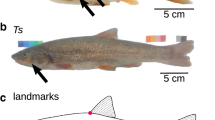Abstract
Two types of males are present in the Jalapa population of Xiphophorus helleri: Males with a black or dark brownish mid-lateral stripe ("black males") mature earlier and are smaller than males with a red or brownish mid-lateral stripe ("red males"). We tested the hypothesis that the colour patterns of red males may be regarded as ornaments, which evolved as the result of inter- and/or intrasexual selection. As predicted, in choice tests females exhibited a strong preference for red versus black males. Furthermore, in competition experiments red males became dominant over black males with no exception, both when body size was equal and even when red males were 3–5 mm smaller than black males. However, contrary to our prediction, sneak–chase behaviour in black males was not detected, and courtship displays occurred at similar rates in both morphs. Red males are always heterozygous, with one allele for red and another for black colouration. This genetic constraint potentially prevents the extinction of the black morph. Possibly, the colour patterns of red males are functioning as indicators of heterozygosity. According to the "heterozygosity theory of mate choice", the female's preference for red males may be adaptive.
Similar content being viewed by others
References
Basolo AL (1990) Female preference for male sword length in the green swordtail, Xiphophorus helleri (Pisces, Poeciliidae). Anim Behav 40:332–338
Basolo AL (1998) Shift in investment between sexually selected traits: tarnishing of the silver spoon. Anim Behav 55:665–671
Brown JL (1997) A theory of mate choice based on heterozygosity. Behav Ecol 8:60–65
Erbelding-Denk C, Schröder JH, Schartl M, Nanda I, Schmid M, Epplen JT (1994) Male polymorphism in Limia perugiae (Pisces: Poeciliidae). Behav Genet 24:95–101
Franck D (1964) Vergleichende Verhaltensstudien an lebendgebärenden Zahnkarpfen der Gattung Xiphophorus. Zool Jahrb Physiol 71:117–170
Franck D, Ribowski A (1989) Escalating fights for rank-order position between male swordtails (Xiphophorus helleri): effects of prior rank-order experience and information transfer. Behav Ecol Sociobiol 24:133–143
Kallman KD (1983) The sex determining mechanism of the poeciliid fish, Xiphophorus montezumae, and the genetic control of the sexual maturation process and adult size. Copeia 1983:755–769
Kallman KD (1989) Genetic control of size at maturity in Xiphophorus. In: Meffe GK, Snelson FF Jr (eds) Ecology and evolution of livebearing fishes (Poeciliidae). Prentice Hall, Englewood Cliffs, N.J., pp 163–184
Kallman KD, Borkoski V (1977) A sex-linked gene controlling the onset of sexual maturity in female and male platyfish (Xiphophorus maculatus), fecundity in females and adult size in males. Genetics 89:79–119
Kallman KD, Schreibman MP, Borkoski V (1973) Genetic control of gonadotrop differentiation in the platyfish, Xiphophorus maculatus (Poeciliidae). Science 181:678–680
Klamroth B (1997) Intra- und intersexuelle Selektion beim Grünen Schwertträger (Xiphophorus helleri). Doctoral dissertation, Universität Hamburg, Germany
Meek SE (1902) A contribution to the ichthyology of Mexico. Field Columbian Mus Publ 65 Zool Ser 3, 6:63–128
Morris MR, Mussel M, Ryan MJ (1995) Vertical bars on male Xiphophorus multilineatus: a signal that deters rival males and attracts females. Behav Ecol 6:274–279
Peters G (1964) Vergleichende Untersuchungen an drei Subspecies von Xiphophorus helleri (Pisces). Z Zool Syst Evolutionsforsch 2:185–271
Rauchenberger M, Kallman KD, Morizot DC (1990) Monophyly and geography of the Rio Panuco basin swordtails (genus Xiphophorus) with descriptions of four new species. Am Mus Novitates 2975:1–41
Ribowski A, Franck D (1993) Demonstration of strength and concealment of weakness in escalating fights of male swordtails (Xiphophorus helleri). Ethology 93:265–274
Rosenthal GG, Evans CS (1998) Female preference for swords in Xiphophorus helleri reflects a bias for large apparent size. Proc Natl Acad Sci U S A 95:4431–4436
Ryan MJ, Causey BA (1989) "Alternative" mating behavior in the swordtails Xiphophorus nigrensis and Xiphophorus multilineatus (Pisces: Poeciliidae). Behav Ecol Sociobiol 24:341–348
Ryan MJ, Hews DK, Wagner WE Jr (1990) Sexual selection on alleles that determine body size in the swordtail Xiphophorus nigrensis. Behav Ecol Sociobiol 26:231–237
Zander CD (1967) Ökologische und morphologische Beiträge zur Systematik und geographischen Verbreitung der Gattung Xiphophorus (Pisces). Mitt Hamburg Zool Mus Inst 64:87–125
Zander CD (1986) Die Jalapa-Population des Schwertträgers Xiphophorus helleri (Pisces, Poeciliidae) als Beispiel für die Evolution des Heterochromosoms. Z Zool Syst Evolutionsforsch 24:129–138
Zimmerer EJ, Kallman KD (1989) Genetic basis for alternative reproductive tactics in the pygmy swordtail Xiphophorus nigrensis. Evolution 43:1298–1307
Acknowledgements
We are grateful to Brigitte Klamroth for helpful suggestions during the experiments. Angelika Taebel-Hellwig and Karin Teege provided technical assistance. Manfred Schartl, Ingo Schlupp, Claus-Dieter Zander, and two referees read an earlier version of the manuscript and made valuable comments. We confirm that our experiments comply with the current laws in Germany.
Author information
Authors and Affiliations
Corresponding author
Additional information
Communicated by R.F. Oliveira
Rights and permissions
About this article
Cite this article
Franck, D., Müller, A. & Rogmann, N. A colour and size dimorphism in the green swordtail (population Jalapa): female mate choice, male–male competition, and male mating strategies. acta ethol 5, 75–79 (2003). https://doi.org/10.1007/s10211-002-0072-3
Received:
Revised:
Accepted:
Published:
Issue Date:
DOI: https://doi.org/10.1007/s10211-002-0072-3




